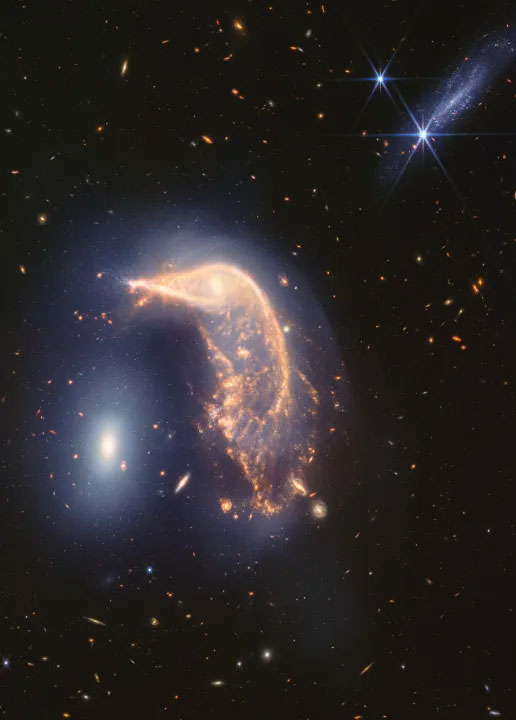Admire the beautiful 'penguin' against the backdrop of space through the eyes of the James Webb telescope
Since then, although it has only been in operation for a short time, James Webb has brought back to humanity countless valuable observations, helping to discover previously unknown galaxies and surprises about the universe. early spacecraft, observed the atmospheres of distant planets, and created countless beautiful images of space.
To celebrate this remarkable milestone, scientists operating the James Webb Space Telescope have released a stunning new image, showing a pair of galaxies performing a complex cosmic dance together. miscellaneous. They combine together to create an image reminiscent of a bright penguin against a deep cosmic sky.

The galactic pair, technically known as Arp 142, have been dubbed 'Penguin and the Egg' because they resemble the head and body of a penguin with an egg next to it. The galaxies' enormous gravity is causing Penguin, a spiral galaxy, to warp and deform into its current form.
All this stretching and bending creates busy regions of star formation as dust and gas gather into dense pockets. The small egg next door is an elliptical galaxy filled with older stars packed more densely than the rather sparse star density in Penguin. This leaves the galaxy's shape virtually unchanged.
This amazing image was created from combining data from James Webb's near and mid-infrared instruments, which use different wavelengths to observe different processes at work. If you just look at the mid-infrared scene, captured with James Webb's MIRI instrument, you can see that some background galaxies (like PGC 1237172 at top right) disappear almost completely at this wavelength targets older stars, while the stars here are very young.
The James Webb Space Telescope is providing insights into long-standing mysteries of the early universe and ushering in a new era of studying distant worlds, while returning telescopic images. inspire people around the world and raise exciting new questions to answer. Exploring every aspect of the universe has never been easier.
You should read it
- Astronomer James Webb finds the most distant galaxy ever observed
- The majesty of the largest galaxy cluster ever known under the eyes of the $10 billion telescope
- James Webb captured the most difficult to find object in the universe, 2,000 light years away
- NASA successfully launched the James Webb space telescope, a 'time machine' that gives us a look into the past of the Universe
- Admire the magical beauty of the Rho Ophiuchi star system through the eyes of the James Webb . telescope
- The Most Powerful Space Telescope Ever Built Will Look Back In Time To The Dark Ages Of The Universe
 Napping really affects longevity!
Napping really affects longevity! 16 unnecessary Windows programs and applications you should uninstall
16 unnecessary Windows programs and applications you should uninstall How to display File Explorer's Preview Pane on Windows 10/11
How to display File Explorer's Preview Pane on Windows 10/11 How to create a Discord account and log in to Discord
How to create a Discord account and log in to Discord Reasons to switch to Apple's password manager
Reasons to switch to Apple's password manager Detecting an unusual object lurking in our Galaxy, possibly a black hole
Detecting an unusual object lurking in our Galaxy, possibly a black hole